Eduard 1/48th Morane-Saulnier Type N
|
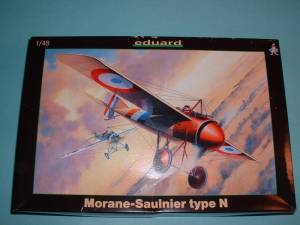 |
The Kit
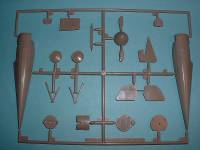 The
Eduard Morane-Saulnier (MoS) Type N consists of 37 injected molded pieces,
along with a set of Express Masks and decals for two options, both French
- a Type N from MS 393 in 1916 and a Type N from MS 394, also in 1916. The
Eduard Morane-Saulnier (MoS) Type N consists of 37 injected molded pieces,
along with a set of Express Masks and decals for two options, both French
- a Type N from MS 393 in 1916 and a Type N from MS 394, also in 1916.
This kit is very well done. While "the truth lies in the pudding",
and in the building of it, I have no doubt that it should build into an
excellent kit, with little to no fuss. Plus, the kit is broken out in
a way that Eduard could easily come out with a Type I, since one of the
major differences between the Type N and Type I lies in the area in front
of the pilot - an area that Eduard has molded separately.
Now I'm not going to put this model "on plans" to see if it's
accurate. For some people that's important, for others it isn't. One thing
I have learned over the years of modeling is that it's more important
if the model looks like what it's supposed to represent. So, while there's
nothing that would suggest otherwise - the wing tips look to be the right
shape, the lack of a sweep in the wing appears correct, etc.- this model
captures the look and "feel" of the MoS Type N.
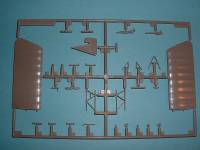 Be
that as it may, there are three areas of this kit that I question - but
only a little - and all of these areas reside in the cockpit. There are
close-up photos of an aviator sitting in the cockpit (smoking, of all
things) and these photos show that the "stringers" on the side
of the cockpit - at least towards the top - are made of metal, perforated
angle. Eduard chose to represent the entire cockpit structure as tubular.
In addition, Eduard provides a complete floor for the cockpit - the current
thinking is that there wasn't a floor and in all actuality the bottom
of the fuselage was the "floor". Finally, Eduard supplies a
"bulkhead-type" piece for the back of the cockpit. Again, current
thinking is that there was nothing behind the seat, and it was open to
the rear of the aircraft. However, there are important factors to take
into effect in Eduard's defense. There are no photos that show the inside
of the cockpit in its entirety - especially the bottom. In addition, there
are no MoS Type Ns nor Type Is left in existence. So, you can either worry
about the current thinking, or have faith in Eduard and rely on what they
provide. It's your call. Be
that as it may, there are three areas of this kit that I question - but
only a little - and all of these areas reside in the cockpit. There are
close-up photos of an aviator sitting in the cockpit (smoking, of all
things) and these photos show that the "stringers" on the side
of the cockpit - at least towards the top - are made of metal, perforated
angle. Eduard chose to represent the entire cockpit structure as tubular.
In addition, Eduard provides a complete floor for the cockpit - the current
thinking is that there wasn't a floor and in all actuality the bottom
of the fuselage was the "floor". Finally, Eduard supplies a
"bulkhead-type" piece for the back of the cockpit. Again, current
thinking is that there was nothing behind the seat, and it was open to
the rear of the aircraft. However, there are important factors to take
into effect in Eduard's defense. There are no photos that show the inside
of the cockpit in its entirety - especially the bottom. In addition, there
are no MoS Type Ns nor Type Is left in existence. So, you can either worry
about the current thinking, or have faith in Eduard and rely on what they
provide. It's your call.
Construction starts with assembling the engine, which consists of three
separate pieces, and looks wonderful. With the right amount of weathering
the engine will definitely look the part. Once that is assembled and put
aside, then cockpit construction starts. Everything you need for the cockpit
- as far as we know - is provided by Eduard, with the exception of seat
belts (and this 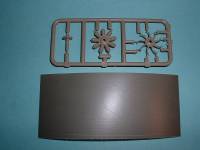 aircraft
could have flown without them). The cockpit pieces are all assembled into
this nice package - that includes back and front bulkheads - which will
then fit easily into the fuselage halves prior to gluing them together. aircraft
could have flown without them). The cockpit pieces are all assembled into
this nice package - that includes back and front bulkheads - which will
then fit easily into the fuselage halves prior to gluing them together.
Now that the fuselage halves are together the wings and horizontal tail
are added. From here you have to make a choice - glue the rest of the
pieces on, or wait until the major parts are painted first. I personally
would deviate from the instructions by gluing on the front, forward fuselage
piece, paint, then follow up by adding the rest of the pieces - landing
gear, upper and lower struts, etc.
One very nice inclusion with this kit are the separate bullet deflectors
for the propellor. The Type Ns all flew with Hotchkiss machine guns with
no interupter gear. Instead, metal deflectors were added to the propellors
to deflect any bullet that might have shot off the propellor.
Once painting is finished and all of the final small pieces added, then
rigging can commence, and I must commend Eduard for including a rigging
diagram. Also nice are the masks that Eduard provide, which include masks
for the horizontal tail pieces so they will have an outline to them. However,
one doesn't have to use these masks - Eduard also provides the outlines
in decal form.
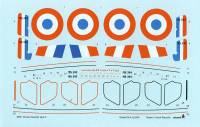 There
are a couple of pluses to the decals. MS 394 has a large tri-color band
on the fuselage sides, but it can't be proved if it's actually a tri-color
- the colors of the French flag - or if it's actually two colors, red
and white only. So Eduard provides both, letting the modeler decide. Plus
they include some "weathering/chipping" decals that you can
place on the front of the fuselage and/or cowl (as these are the only
metal parts of the aircraft). In addition, they provide rudder decals
in one of two ways - with or without the French national colors. This
way, if you're the type of modeler that paints his or her rudders, then
you still have the decals to cover the aircraft number found there. There
are a couple of pluses to the decals. MS 394 has a large tri-color band
on the fuselage sides, but it can't be proved if it's actually a tri-color
- the colors of the French flag - or if it's actually two colors, red
and white only. So Eduard provides both, letting the modeler decide. Plus
they include some "weathering/chipping" decals that you can
place on the front of the fuselage and/or cowl (as these are the only
metal parts of the aircraft). In addition, they provide rudder decals
in one of two ways - with or without the French national colors. This
way, if you're the type of modeler that paints his or her rudders, then
you still have the decals to cover the aircraft number found there.
Conclusion
This is an awesome kit. If I were to build in 1/48th (not very likely)
I would definitely be working on this model now. It's very well done and
will look wonderful built up. Now if Eduard would only scale it to 1/72nd,
I would be an extremely happy modeler. Definitely, highly recommended.
My thanks to Eduard for the review
sample.
|
|
